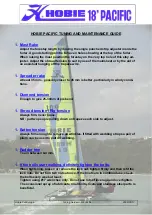
15
1.1 General
Your boat and outboard engines have been
equipped with safety equipment designed to en-
hance the safe operation of the boat and to meet
U.S. Coast Guard safety standards. The Coast
Guard or state, county and municipal law enforce-
ment agencies require certain additional accessory
safety equipment on each boat. This equipment
varies according to length and type of boat and
type of propulsion. The accessory equipment typi-
cally required by the Coast Guard is described in
this chapter. Some local laws require additional
equipment. It is important to obtain “Federal
Requirements And Safety Tips for Recreational
Boats,” published by the Coast Guard and copies
of state and local laws, to make sure you have the
required equipment for your boating area.
Your boat is equipped with engine alarms. The
alarm systems are designed to increase your boat-
ing safety by alerting you to potentially serious
problems in the primary power system. Alarm
systems are not intended to lessen or replace good
maintenance and pre-cruise procedures.
This chapter also describes safety related equip-
ment that could be installed on your boat. This
equipment will vary depending on the type of
engines and other options installed by you or
your dealer.
1.2 Engine Alarms
Most outboard engines are equipped with an au-
dible alarm system mounted in the helm area that
monitors selected critical engine systems. The
alarm will sound if one of these systems begins to
fail. Refer to the engine owner’s manual for infor-
mation on the alarms installed with your engines.
If the alarm sounds:
• Immediately throttle the engines back to idle.
• Shift the transmissions to neutral.
• Monitor the engine gauges to determine the
cause of the problem.
• If necessary, shut off the engine and investigate
until the cause of the problem is found.
1.3 Neutral Safety Switch
Every control system has a neutral safety switch
incorporated into it. This device prohibits the
engines from being started while the shift levers
are in any position other than the neutral posi-
tion. If an engine will not start, slight movement
of the shift lever may be necessary to locate the
neutral position and disengage the safety cutout
switch. Control adjustments may be required to
correct this condition should it persist. See your
Crevalle dealer for necessary control adjustments.
Please refer to the Helm Control Systems chapter
for more information on the neutral safety switch.
1.4 Engine Stop Switch
Your boat is equipped with a engine stop switch
and lanyard. When the lanyard is pulled it will
engage the switch and shut off the engines. We
strongly recommend that the lanyard be attached
to the driver and the stop switch whenever the
engines are running. If the engines will not start,
it could be because the lanyard is not properly in-
serted into the engine stop switch. Always make
sure the lanyard is properly attached to the engine
stop switch before attempting to start the engine.
Notice:
In some states, a lanyard attached to the
driver at all times is required by law.
Throwable Device & Personal PFD
Chapter 1:
SAFETY EQUIPMENT
Содержание 33 CSF
Страница 1: ...Crevalle 33 CSF Owner s Manual...
Страница 2: ...2...
Страница 10: ...10 NOTES...
Страница 14: ...14 NOTES...
Страница 23: ...23 Operation...
Страница 74: ...74 NOTES...
Страница 78: ...78 NOTES...
Страница 84: ...84 NOTES...
Страница 116: ...116 NOTES...
Страница 124: ...124 NOTES...
Страница 130: ...130 NOTES...
Страница 146: ...146 NOTES...
Страница 167: ...167 MAINTENANCE LOG Appendix C Date Hours Dealer Service Repairs...
Страница 168: ...168 Maintenance Log Date Hours Dealer Service Repairs...
Страница 169: ...169 Appendix D BOATING ACCIDENT REPORT...
Страница 170: ...170 Boating Accident Report...
Страница 171: ...171 Boating Accident Report...
Страница 172: ...172 NOTES...
Страница 174: ...174 NOTES...
Страница 180: ...180 NOTES...
Страница 186: ...186...
Страница 187: ...187 CAUSE AND SOLUTI...
Страница 188: ...188 Rev 0 10 23 2020 Crevalle Boats Littoral Marine LLC 1520 Industrial Drive Wildwood FL 34785...
















































